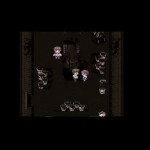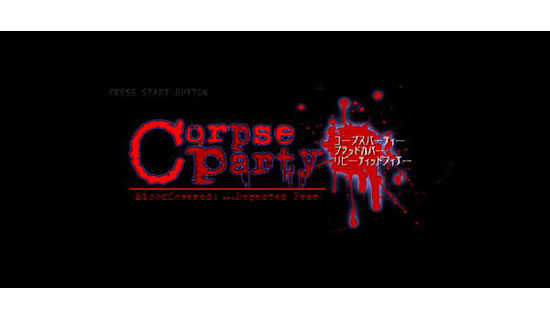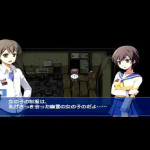Both the horror and visual novel genres have rich histories within the world of Japanese games. And given the emphasis that they both place on story telling as a key component, it makes complete sense that there would be games that mix in elements of both. The Corpse Party series was certainly not the first to take this step, though it’s one of the more recent success stories. And since it took awhile for a non-computer version to be developed, it’s not even as recent as most might think.
The first installment in the Corpse Party series is a 1996 vintage. It was created in the now fairly well known piece of software “RPG tsukuuru” (or “RPG Maker”) on the PC98 series of Japanese home computers, and was developed by Team GrisGris and written by Kedouin Makoto. It won an award at the Ascii Entertainment Software Contest the very same year, and it was actually being distributed online as freeware. At this point it was a horror-themed RPG, featuring menu-based battles like just about every other major RPG of the time. Corpse Party began life as the very definition of a doujin game, and the Corpse Party name would be dormant for the next 12 years.
In 2008 the creators of the original Corpse Party surfaced to give the series not only upgrades in the graphics, music and writing department, but also fundamentally changed the way that the game played. With “Corpse Party BloodCovered” (BC), the 3/4 overhead view and horrific scenarios were about the only aspects from the original that were kept. Gone were the typical RPG-style battles, turning the overhead sections to be more about puzzle solving (and sometimes avoidance), where you had to figure out which aspects of the environment to interact with in order to progress. The popularity of the visual novel genre was also in full swing, so plenty of visual novel style cut scenes were also brought in to tell parts of the story. While the overhead parts of the game were still very much in a 16-bit art style, the cut scenes were in one much closer to that of popular anime. This version was once again released as a doujin game (on the Windows platform now), but this time they actually sold it. It was made available at conventions, and both retail and online doujin game shops. Team GrisGris then began working with 5pb. to get a version of BloodCovered on the PSP, marking the first mass consumer version of the game to exist.
Now it should be mentioned that no one involved expected Blood Covered: …Repeated Fear (BCRF) to sell very many copies, even on the PSP (which at this point has secured its place in handheld gaming history, largely due to the popularity of the Monster Hunter series). Sure they were adding a fifth chapter that was not present in the earlier Windows version (which would result in some alterations to the story), and even an Extra Chapter mode where some further new content could be played. Much of the art was also going to be completely redone, resulting in a noticeable increase in production values. However the contents of the game itself are not necessarily for the feint of heart. Now we come to the point where it’s necessary to actually understand what makes Corpse Party so different from a lot of other horror or visual novel games.
First and foremost is the story, and in this way the anime aesthetic that both BC and BCRF are presented in can be very misleading. It’s true that all of the visual novel cut scenes and even key art are presented in not a “moe” style (the female characters are much too well endowed to call it that), but what is perhaps a more ‘cutesy” style than one would expect from a horror game. Additionally you’ll quickly find that the game is not shy about following other anime tropes regarding the classic students in a haunted school setting, character personalities (at least at first), voice acting (again, only at first) and even plenty of panty shots. I admit that I was a bit leery of the game due to its initial presentation. In fact making it through the first chapter of BCRF was difficult for me, because Corpse Party doesn’t really show its true self until a bit later.
Character and setting tropes are quickly tossed aside and art style preferences are forgotten once the game properly introduces itself. Characters will die and gruesome things will happen, but the way in which the game presents these things is extremely unique and creative. You might think that the visual novel style cut scenes would be the primary way in which these gruesome events are depicted, but that is not typically the case. You’ll sometimes see gore rendered in the game’s pseudo 16-bit style when traversing your surroundings, but the key to the horror lies almost entirely in the fantastic sound design and voice acting. Make no mistake, this is absolutely the major draw in BCRF.
 |  |
| Figuring out what to say when you walk into the hall with all of the bloody skulls on the tables… | Or when you have to hide in a room where there are buckets of blood everywhere… |
The audio was specifically redesigned for wearing headphones, so I cannot recommend doing this enough if you are playing this version of the game on a PSP. You’ll hear every squishy sound that comes from a body being torn apart in some grotesque way, to the point where you start to question the methods that the design team actually used to produce these sounds. And as the story progresses to where the characters discover the true horror of the situation in what they are trapped, the voice cast ramps up their performance to match. BCRF could truly be used to teach a course in great sound design and voice acting in video games. Should you decide to play this game in Japanese without the aid of any English subtitles, the language barrier is not extremely high (save for any scenes involving news reports) as long as you have a decent grasp on the language. This is helped largely by the game being very nearly fully voiced, which is a rare feat for a PSP game.
Corpse Party BCRF is one of the most expectation defying games I’ve played in a long time. In my case, some were expectations that I mistakenly created for myself based on art. However, the game really does set itself up to make you believe it’s something different than what it later reveals itself to be. In fact after this version of the game, the popularity of the series blew up quite dramatically. It’s had several sequels and side story games, as well as a number of anime, manga, drama CDs, and even an upcoming (at the time of this writing) live action movie. Corpse Party is on the front lines of the small revival of Japanese horror output that’s currently underway. If you like a good Japanese style horror story and aren’t adverse to visual novel elements and some game play straight out of the 16-bit era, you really can’t go wrong with Corpse Party BCRF.


